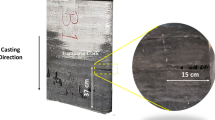Abstract
The room-temperature tensile and high-cycle fatigue (HCF) behavior of orthorhombic Ti-22Al-27Nb alloy with varying lamellar morphology was investigated. Varying lamellar morphology was produced by changing the cooling rate after annealing in the single B2 phase region. A slower cooling rate of 0.003 K/s, for example, resulted in several large packets or colonies of similarly aligned O-phase lamellae and a nearly continuous massive α 2 phase at the prior B2 grain boundaries, while a faster cooling rate of 0.1 K/s led to the refinement of colony sizes and the O-phase lamellae. The interface of O-phase lamellae and B2 phases was semicoherent. Water quenching produced a very fine tweed-like microstructure with a thin continuous O phase at the prior B2 grain boundaries. The 0.2 pct yield stress, tensile strength, and HCF strength increased with increasing cooling rate. For example, the tensile strength and HCF strength at 107 cycles of 0.003 and 0.1 K/s-cooled were 774 and 450 MPa, and 945 and 620 MPa, respectively. Since the fatigue ratio, which is the ratio of HCF strength at 107 cycles to tensile strength, did not show a constant value, but instead increased with increasing cooling rate, part of the fatigue improvement was the result of improved resistance to fatigue associated with the microstructural refinement of the lamellar morphology. Fatigue failure occurred by the subsurface initiation, and every initiation site was found to contain a flat facet. Concurrent observation of the fatigue initiation facet and the underlying microstructure revealed that the fatigue crack initiated in a shear mode across the colony, irrespective of colony size, indicating that the size of the initiation facet corresponded to that of the colony. Therefore, the colony size is likely a major controlling factor in determining the degree of fatigue improvement due to the microstructural refinement of lamellar morphology. For the water-quenched specimens, fatigue crack initiation appeared to be associated with shear cracking along the boundary between the continuous grain boundary O phase and the adjacent prior B2 grain.
Similar content being viewed by others
References
D.A. Koss, D. Banerjee, D.A. Lukasak, and A.K. Gogia: High Temperature Aluminides and Intermetallics, TMS, Warrendale, PA, 1990, pp. 175–96.
Y.-W. Kim: J. Met., 1989, vol. 41, pp. 24–30.
R.G. Rowe: Microstructure/Property Relationship in Titanium Aluminides and Alloys, TMS, Warrendale, PA, 1991, pp. 387–98.
R.G. Rowe: Titanium ’92—Science and Technology, TMS, Warrendale, PA, 1993, pp. 343–50.
C.J. Boehlert, B.S. Majumdar, V. Seetharaman, and D.B. Miracle: Metall. Mater. Trans. A, 1999, vol. 30A, pp. 2305–23.
C.J. Boehlert and D.B. Miracle: Metall. Mater. Trans. A, 1999, vol. 30A, pp. 2349–67.
J.W. Zhang, C.S. Lee, D.X. Zou, S.Q. Li, and J.K.L. Lai: Metall. Mater. Trans. A, 1998, vol. 29A, pp. 559–64.
Y. Mao, S.L. Li, J.W. Zhang, J.H. Peng, D.X. Zou, and Z.Y. Zhong: Intermetallics, 2000, vol. 8, pp. 659–62.
J. Kumpfert and C. Leyens: Structural Intermetallics 1997, TMS, Warrendale, PA, 1997, pp. 895–04.
J. Kumpfert and W.A. Kaysser: Z. Metallkd., 2001, vol. 92, pp. 128–33.
A.K. Gogia, T.K. Nandy, D. Banerjee, T. Carisey, J.L. Strudel, and J.M. Franchet: Intermetallics, 1998, vol. 6, pp. 741–48.
F. Tang and M. Hagiwara: Metall. Mater. Trans. A, 2003, vol. 34A, pp. 633–43.
S. Emura, A. Araoka, and M. Hagiwara: Scripta Mater., 2003, vol. 48, pp. 629–34.
S.J. Yang, S.W. Nam, and M. Hagiwara: J. Alloys Compounds, 2003, vol. 350, pp. 280–87.
J.H. Peng, Y. Mao, S.Q. Li, and X.F. Sun: Mater. Sci. Eng., 2001, vol. A299, pp. 75–80.
G. Lutjering, J. Albrecht, and O.M. Ivasishin: TITANIUM ’95, The Institute of Materials, London, 1995, pp. 1187–94.
L.A. Bendersky, W.G. Bottinger, and A. Roytburt: Acta Metall. Mater., 1991, vol. 39, pp. 1959–69.
F.A. Sadi and C. Servant: Mater. Sci. Eng., 2001, vol. A346, pp. 19–28.
J.W. Zhang, S.Q. Li, D.X. Zou, W.Q. Ma, and Z.Y. Zhong: Intermetallics, 2000, vol. 8, pp. 699–02.
K. Ito, L.T. Zhang, V.K. Vasudevan, and M. Yamaguchi: Acta Mater., 2001, vol. 49, pp. 963–72.
D. Eylon and C.M. Pierce: Metall. Trans. A, 1976, vol. 7A, pp. 111–21.
D. Eylon: J. Mater. Sci., 1979, vol. 14, pp. 1914–22.
D. Eylon and J.A. Hall: Metal. Trans. A, 1977, vol. 8A, pp. 981–90.
J.C. Williams and G. Luetjering: TITANIUM ’80, Science and Technology, The Japan Institute of Metals, Sendai, 1980, pp. 671–81.
K.S. Ravichandran, E.S. Dwarakadasa, and D. Banerjee: Scripta Metall. Mater., 1991, vol. 25, pp. 2115–20.
K.S. Ravichandran: Acta Metall. Mater., 1991, vol. 39 (3), pp. 401–10.
M. Hagiwara, Y. Kaieda, Y. Kawabe, and S. Miura: Iron Steel Inst. Jpn. Int., 1991, vol. 31, pp. 922–30.
M. Hagiwara, S.J. Kim, and S. Emura: Scripta Mater., 1998, vol. 39 (9), pp. 1185–90.
Author information
Authors and Affiliations
Rights and permissions
About this article
Cite this article
Hagiwara, M., Emura, S., Araoka, A. et al. The effect of lamellar morphology on tensile and high-cycle fatigue behavior of orthorhombic Ti-22Al-27Nb alloy. Metall Mater Trans A 35, 2161–2170 (2004). https://doi.org/10.1007/s11661-004-0164-y
Received:
Issue Date:
DOI: https://doi.org/10.1007/s11661-004-0164-y




